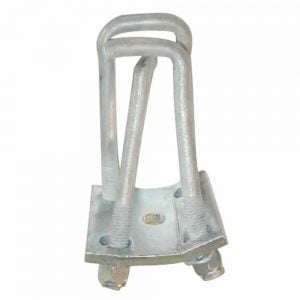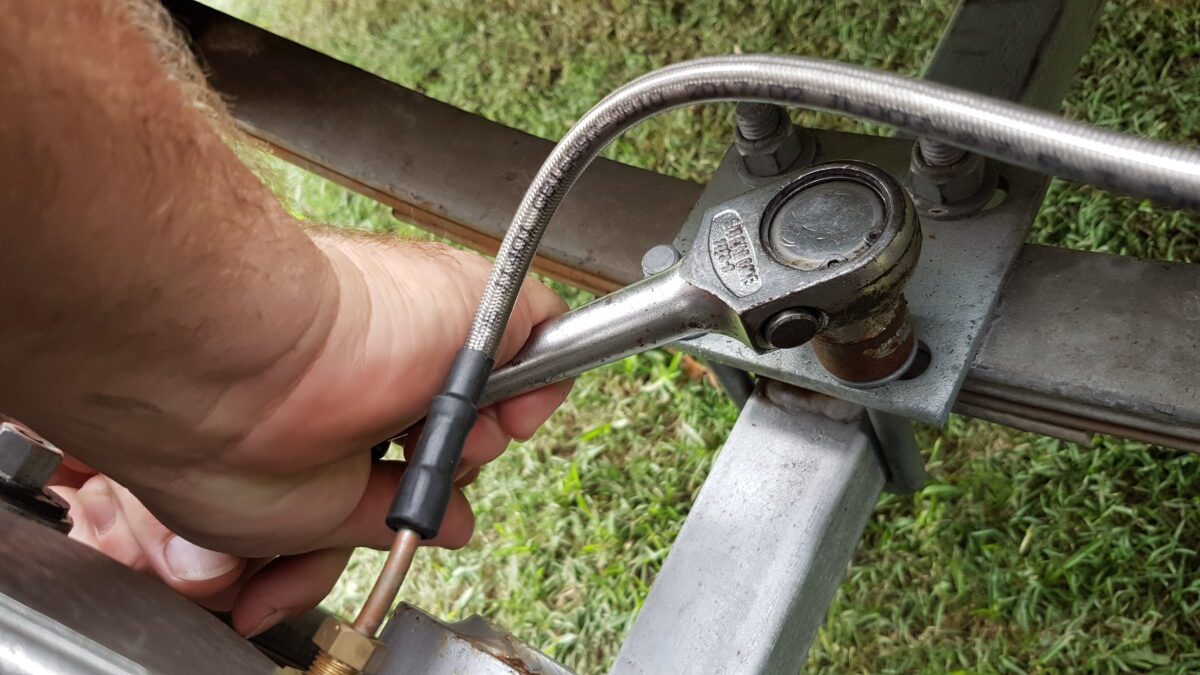U-bolts Maybe the Major Cause of Accidents
U-bolts are not usually assessed as the culprit in caravan accidents or rollovers, possibly due to the enormous carnage at an accident scene. Our industry has no Australian Standards for caravan or trailer u-bolts, so they have not been recognised as a problem.
Steel has an exact amount of carbon for each grade of steel. Carbon steel has various mechanical properties that produce medium or high-strength steel.
When steel is heated, hydrogen gas attacks steel aness to the steel. Hydrogen embr,ittlement occurs at this time, producing stress corrosion cracking only visible under x-ray.
Bad bearings, broken springs and lost wheel nuts are blamed as the cause of most caravan accidents.
Hydrogen Embrittlement
However, the culprit in many caravan and trailer accidents is the hydrogen embrittlement embodied during manufacture.
Hydrogenmanufacturing industry’s he most underestimatein the manufacturing industry.
Fact: A Hydrogen content or embrittlement is embedded in all steel proFor ducts that have undergone some heating process.
For Example, plating tow balls install hydrogen embrittlement into the tow ball. Tow balls must then be de-embrittled via an elevated emperature and then slowly cooled to room temperature, to remove the embrittlement.
Read more about hydrogen embrittlement here.
How do I know if I have the right equipment on my caravan?
U-bolts are often overlooked and just not on the maintenance checking schedule before your next caravan trip.
It is difficult for manufacturers to produce a standard u-bolt as there is no tensile strength or Australian Standard.
 Couplemate have decided to undertake tests similar to rated Dee Shackles. The test for dee shackles is breaking load limited (BLL) / 6 = working load limit (WLL). (not the ATM). To calculate the ATM, divide the WLL by 1.5.
Couplemate have decided to undertake tests similar to rated Dee Shackles. The test for dee shackles is breaking load limited (BLL) / 6 = working load limit (WLL). (not the ATM). To calculate the ATM, divide the WLL by 1.5.
For example, if heavy-duty u-bolts break at 23t, the rated load limit is 5.75t.
ATM is calculated at 5.75t / 1.5 = 3.83t max load.
Therefore, a 5/8″ Couplemate u-bolt kit has been tested to a maximum ATM capacity of 3.83t
The image on the right is from our 200t test rig. A force was gradually applied until breakage occurred at 23t. We called this the BLL or break load limit.
By applying the Dee Shackle or Bow shackle testing regime, we can apply a maximum safety rating of 3.83t per axle for this type of u-bolt.
Heavy Duty U-bolt Kit specifications are
- 2 x 5/8″ BSW Galvanised mild steel u-bolts
- 4 x 5/8″ BSW nylocks and washers.
- 1 x 10mm Galvanised mild steel plate.
Spring and Axle Connection
It is a common practice by some caravan manufacturers to put springs above the axle to give extra height. Contrary to popular opinion, Couplemate not only thinks this is a bad idea, but it is unsafe and contributes to road accidents.
Axles are usually located above the spring and enclosed by the spring and the chassis rails.
What buyers do not know is there is no Australian Standard to test u-bolts used by caravan and trailer manufacturers.
Hydrogen embrittlement causes steel to become brittle and fracture on the bend during a tensile stress test. The steel rod on the left was bend by bare hands and suffered a loss of ductility
This is caused by absorbed hydrogen or absorbed hydrogen atoms and is the principal cause of hydrogen embrittlement.
The effect of hydrogen embrittlement results in U-bolts becoming. There is zero chance of effectively clamping your axle to your caravan spring when residual stress remains in your U-bolts.
Fractured U-Bolts
A fractured U-bolt when the axle is under the spring means the axles can easily break free once the u-bolt breaks, releasing the axle from under the rear of the caravan. The potential for road carnage to innocent travellers behind you is horrific.
Our remedy to combat hydrogen embrittlement inserts an additional process into the manufacture of u-bolts. This process removes hydrogen embrittlement.
When making your spring choices be sure to purchase Couplemate U-bolt kits to suit.
Snapping U-bolts
Hydrogen embrittlement can be readily determined by breakage at the corner of the U-bolt when it has been bent.
All bends should have a least a 5mm radius otherwise they will not match the 5mm radius curve on your axle. This radius is a critical pressure point. It is easily eliminated.
U bolts are the only thing holding your entire caravan onto the road. They bind your axle to your springs and then your chassis.
U-bolts are not a disposable item like grease or bearings or tyres. They are in place for the life of your caravan,
How important is a u-bolt check?
I installed new U-bolts in Brisbane and headed down to the Hawkesbury River for Christmas with the boat in tow (top image)
It was a lovely, uneventful trip but now it’s time to check a few things.
Top of the list this time is U-bolts. Told my brother-in-law all about mild steel stretching and how these nuts will probably tighten 1/2 turn. As suspected, all the nuts needed 1/2 a turn to make them tight again.
When was the last time you checked your nuts?
Especially on new caravans. Do not wait for the first service for what looks like a faulty spring is actually lose u-bolts. Grab your wrench and socket. Test them and tell us what you find!
U bolts are a major factor in correcting caravan wheel alignment.
© Steve Wotherspoon 8th August 2017

Wow steve…what a quick response and thank you for the advice….but of course I didn’t need it – as i had already read that clearly on your sight LOL …cheers
Hi Steve,
Parts arrived Friday and we fitted springs on one side of van with a great result (about an 85mm lift).
We will tackle the other side when the balance of order arrives next week.
Thank you for providing an informative and educational website and timely and friendly service.
Just a FYI. When I tightened the Nylock Nuts onto the U-Bolts, the nylon bush in the nut was squeezed out of the nut. As this occurred about half way up the tread and after much effort spent, I decided to fully tighten these. I intend to purchase more nuts to finish the job (on just one fish plate). Would just using non-locknuts do the job, having 2 nuts per thread (locknut + normal jam nut)?
I discovered the reason for the problem was that possibly in the “galvanising” process that “dross” fills the thread which makes for a very tight nut fit and it squeezes the nylon out of the locknut. Solution was to wire brush each bolt to eradicate this on the second fitting (of dual axle).
If this is normal for a bolt to be presented like this (although not at all matching sample photo on website) may I suggest a note to the end user to “wire brush the dross” so as not to have my experience as a recurring one en masse.
Thank you again for what overall is a great product in leaf springs ….cheers
Ps I wrote this in the first person “I”….but in actuality, yes, my good friend Robert did most of the grunt, although I did pass him the tools in a very timely and professional manner. LOL
regards,
Max.
Hello Max, Fantastic feedback that I have forwarded back to our manufacturer. We have manufactured this u bolt for 10 years and not experienced the problem you mentioned. Obviously, the coating varies from batch to batch or from u bolt to u bolt.
However, your excellent writing style clearly identifies there is a problem and we will look at it.
We do have oversized die nuts that we run over heavily galvanised u bolts. We have not previously identified the problem you suggested.
Therefore, we will address this problem in the manufacturing area.
Thank you again for your advise, Steve Wotherspoon
Hi… had a close call this week when pulling out of the driveway at home (1 week after returning from a 7,000 km road trip) towing a 2.8 ton Traveller Caravan. I heard 2 “clinks” as something fell to the road. I stopped and upon inspection found 2 short pieces of “leaf spring” broken with half a hole at the break point. It got worse as I lay on my back inspecting the dual axle leaf springs I discovered that on the front driver side axle ALL leaves were broken at the same halfway point and were missing (except for the one attached to the eye bolt. I immediately thought “I hope some poor b— has not worn them as they travelled behind me” and then it was me that was HIT – with reality! – as I realised that it was me and my family that had “dodged a bullet”. Now my thoughts changed from “idiom” to “idiot” for having not routinely checked the underside (although in May before our 7,000km trip I had the bearings re=greased a and a safety check) – ‘cos these things sneak up on ya!. So, aborting the planned 500 km trip to Mt Gambier, I attempted to back the van into the drive. Suddenly the last leaf broke (I could picture in my mind a camel back there with a straw and a broken back). Now it got really tricky as I was getting a slow motion frame by frame picture of what could have happened at highway speed as the front axle dropped, dislodged and moved forward jamming and squashing the tyre up into the underside of the wheel arch. Thankfully my good buddy and fellow caravanner was on the scene to “walkie talkie” me through the incident as a row of traffic applauded (silently I think) as we arrested the situation and proceeded to chock it up. I am now waiting on a full replacement kit for ALL 4 springs. Thank-you Couplemate for such informative articles and videos on this site and for giving me the confidence to not only hand the tools to my good buddy as we work on it “together” but the awareness to check, yes the new U-Bolts after 500 km and implement a full underside check on a cyclical basis. If you are a caravanner, a boatie or tow anything with springs, please, please consider your own maintenance programme as I don’t want to be travelling behind anyone who hasn’t implemented one. LOL.
Cheers / Max from Nairne